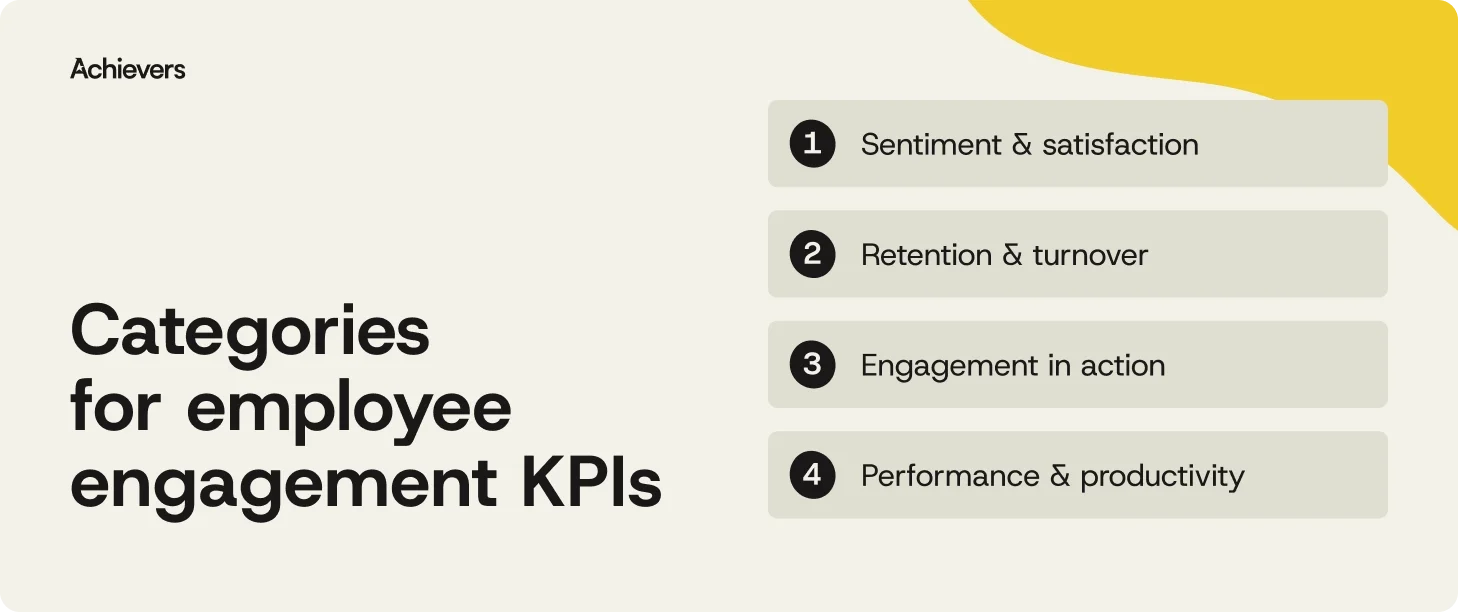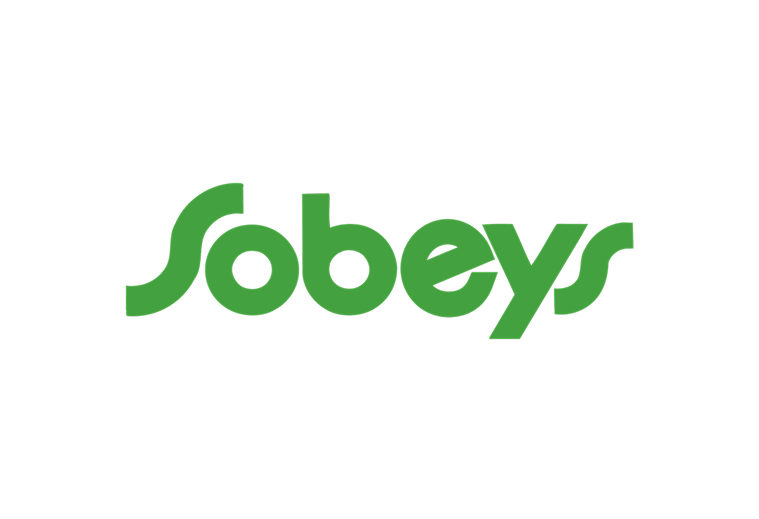Table of contents
Create a culture that means business™
Schedule a demo with an Achievers solution expert today.
You can’t improve what you don’t measure. And when it comes to employee engagement, there’s a lot to measure. Sure, engagement is a feeling — but KPIs are how you find the facts hiding underneath.
Are your people inspired or just in survival mode? Are recognition efforts sticking, or skimming off the top? Tracking the right engagement KPIs helps you figure out what’s working, what’s flopping, and what just needs a snack break before it gets back on track.
This article walks you through 20 essential employee engagement KPIs that help HR leaders and managers do more than guess — they help you shape your workforce. Because when you’ve got a pulse on your people, you can fuel the behaviors that lead to real results.
So, let’s dive into the metrics that matter.

Employee sentiment and satisfaction KPIs
Engagement isn’t just about performance dashboards and productivity charts. It’s also about emotion. The warm, fuzzy stuff that determines whether people feel valued, supported, and — dare we say it — happy at work.
These KPIs help you take the emotional pulse of your organization. And if the heartbeat’s off, it’s time to dig deeper:
- eNPS (Employee Net Promoter Score): Would your employees recommend your company to a friend — or are they warning them to run for the hills? This simple score is a telling indicator of pride, loyalty, and advocacy (or lack thereof).
- Employee satisfaction score: A straightforward metric with serious depth. It’s your go-to pulse check for how employees are feeling day-to-day — without needing a full-blown focus group.
- Recognition frequency: If people are doing great work but no one’s acknowledging it, that’s not just demotivating — it’s a culture problem. Recognition shouldn’t be a rare sighting. If it is, it’s a red flag with sad eyes and low retention.
- Well-being index: Burnout doesn’t announce itself politely. By the time it shows up on an exit survey, it’s too late. Track well-being early and often to catch signs of stress before they snowball.
- Manager effectiveness rating: Let’s be honest — no one quits spreadsheets; they quit managers. This KPI helps you understand whether leaders are building trust or breaking it. Spoiler: The latter can tank engagement faster than the office running out of coffee.
These aren’t just feel-good metrics — they’re business-critical. Because when your people feel supported, seen, and satisfied, everything else starts to fall into place.
Employee retention and turnover KPIs
Behind every employee who leaves, there’s a story. And behind every employee who stays, there’s usually a reason, too. Engagement lives in those reasons — and so do some of your most important KPIs.
These metrics help you track what’s keeping people connected to your company — and what’s nudging them toward the exit:
- Voluntary turnover rate: When someone chooses to leave, it’s never “just because.” There’s always a reason — whether it’s burnout, bad management, or a better offer. This metric helps you spot patterns before your best talent ghosts you.
- Regrettable attrition rate: Not all departures hit the same. This one zooms in on the people you didn’t want to lose — and gives you the data to figure out what could’ve changed the outcome.
- Retention rate (new hires + tenured employees): Engagement doesn’t wear the same outfit on day 30 as it does on year 10. Measuring retention across both new hires and long-haulers helps you see where your strategy needs to flex.
- Exit interview themes: Technically qualitative, but don’t let that fool you. There’s gold in what people say on the way out — if you’re willing to listen, synthesize, and take action (and maybe let go of the “they just weren’t a culture fit” reflex).
- Internal mobility rate: If your people are growing with you — moving into new roles, tackling new challenges — they’re less likely to grow away from you. This KPI tracks whether you’re developing talent or just renting it.
Retention metrics don’t just tell you who’s walking out the door — they help you understand why. And when you pair them with action, they can help you turn the tide.
Employee engagement in action KPIs
Engagement isn’t just a vibe — it’s a verb. It shows up in the day-to-day: in conversations, collaboration, and those small but meaningful moments where people go beyond their job descriptions.
These KPIs shine a light on how engaged your employees really are — not just how they say they are:
- Participation in recognition programs: People who feel valued tend to show up for each other. If your recognition program feels like a ghost town, that’s a sign something deeper is off. Engagement looks like, “Thank you,” not just, “That’s above my pay grade.”
- Survey response rates: If you send out surveys and hear crickets, that silence speaks volumes. Low participation might mean disengagement — or it might mean your people don’t trust that their input will lead to change. Either way, it’s worth investigating.
- Idea submission rate: Are employees actively contributing ideas — or just clocking in and zoning out? This metric helps you spot where innovation is thriving… and where it’s running on fumes.
- Meeting attendance & engagement: Being in the meeting isn’t the same as being in the meeting. Look for signs of real participation — not just cameras on, but ideas shared, questions asked, and maybe even the occasional unmuted laugh.
- Cross-team collaboration: Siloed teams don’t make for strong cultures. Tracking collaboration across departments helps you gauge whether your organization feels like one company — or just a lot of Zoom links with logos in common.
When employees are truly engaged, it shows. These KPIs help you see that energy in action — and catch the quiet moments where it might be slipping.
Employee performance and productivity KPIs
While engagement is rooted in connection, recognition, and culture, it also plays a starring role in outcomes. When employees are truly engaged, the business feels it — in the KPIs that show up on executive dashboards.
Here’s how to track whether engagement is driving real, measurable performance:
- Goal completion rates: Engaged employees deliver. They don’t just show up — they show up with purpose. High goal completion signals alignment, motivation, and the kind of follow-through that moves the business forward.
- Productivity per employee: This isn’t about glorifying the grind. It’s about the quality of output and the heart behind the hustle. Engaged employees tend to be more focused, efficient, and collaborative — without burning themselves out in the process.
- Absenteeism rate: When people don’t want to be at work, they’ll find a way not to be. A rising absenteeism rate can signal disengagement, stress, or — let’s be real — coffee that tastes like regret. Either way, it’s worth a closer look.
- Time to productivity (new hires): A well-engaged new hire gets up to speed faster. If it’s taking ages for fresh talent to find their stride, your onboarding (or culture) might be slowing them down.
- Training participation & completion: Engaged employees invest in their growth. Tracking training metrics helps you spot where people are leaning in — and where they’ve mentally left the building.
These metrics don’t just reflect what people are doing — they reflect how they feel while they’re doing it. And that’s what makes them essential to shaping a workforce that performs with purpose.
Employee data and insights: Creating balanced KPIs
KPIs are powerful. They highlight trends, reveal gaps, and show you exactly where to focus. But at the end of the day, they’re not just numbers on a dashboard — they’re signals from real people, living real experiences inside your organization.
Employee recognition gives those numbers context. It turns data into action, and metrics into meaning. Because while it’s critical to keep a pulse on performance, retention, and sentiment, it’s even more important to remember what those metrics represent: people who want to be seen, heard, and inspired to do their best work.
Need help tracking the right KPIs — or better yet, moving them in the right direction? Let’s just say Achievers has a thing for turning values into behaviors into results.
Magic not included — just science. And a whole lot of recognition.





